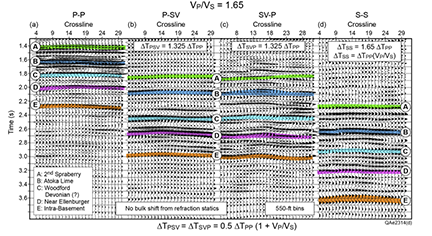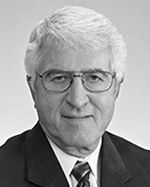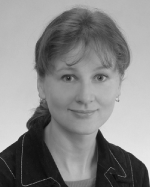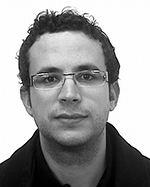 |
Geophysics |
New Approach to Seismic Imaging of CO2 Storage Reservoirs and Seals

|
An example of the first-ever full-elastic wavefield produced using only vertical vibrator sources. The sensors were 3C geophones. When vertical-vibrator data are recorded by only single-component vertical geophones, the SV-P mode (panel c) still provides an S-wave image and S-wave attributes. |
Optimal characterization of a CO2 storage reservoir and its sealing units requires that geological conditions extending from the earth surface to units below a target reservoir be imaged with full-elastic seismic wavefields. To achieve this objective, geology must be illuminated not only by conventional P-P waves, but also by all possible S-S modes (both fast and slow modes), all possible converted-wave modes (P-SV and SV-P), and diffraction imaging must also be done in addition to reflection imaging. The GSCO2 addresses this challenge by using seismic imaging technology that has not been utilized in any DOE-supported CO2 storage project. This technology is based on the fundamental concept that all seismic sources used to create P-wave illuminating wavefields (vertical vibrators, vertical impacts, shot-hole explosives) create more direct-SV energy than direct-P energy. This fundamental wave physics has been ignored by geophysicists engaged in seismic reflection seismology. The illuminating direct-S modes produced by common “P-wave” sources provide the means whereby full-elastic wavefields illuminate a CO2 reservoir and seal. 3C geophones must be deployed to acquire all wave modes involved in full-elastic wavefield illumination with P-wave sources (see figure). Such 3C data have been acquired at the GSCO2 as 3C3D vertical seismic profile (VSP) data. When three-dimensional (3D) surface-seismic data are acquired with P-wave sources and only 1C vertical geophones as has been done at the GSCO2, S-wave illumination can still be done by utilizing the SV-P mode (panel c, figure). This SV-P mode is embedded in vertical-geophone data together with the conventional P-P mode. The SV-P images that the GSCO2 will produce from surface-based vertical-geophone data will be the first SV-P images ever made across a CO2 storage site.
Deep Seismic
Bob A. Hardage, PhD
|

Michael V. DeAngelo, MS
|

Diana Sava, PhD
|
Pore Scale, Petrophysics, and Seismic
Michael Jordan, PhD
|

Anouar Romdhane, PhD
|
